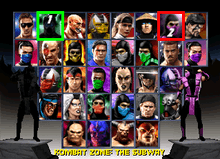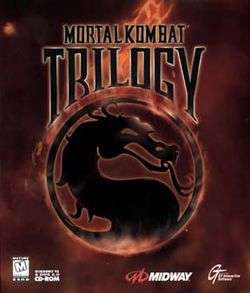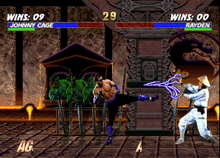Mortal Kombat Trilogy
| Mortal Kombat Trilogy | |
|---|---|
|
Cover art | |
| Developer(s) |
Avalanche Software (PlayStation) Midway Games (N64) Point of View, Inc. (PC, Saturn) |
| Publisher(s) |
Williams Entertainment (1996 releases) Midway Games (1997 and onwards releases) GT Interactive (PC and European releases) SoftBank (Japanese release) Gradiente, Tectoy (BR) |
| Designer(s) | Ed Boon and John Tobias |
| Composer(s) | Dan Forden |
| Series | Mortal Kombat |
| Platform(s) | Nintendo 64, PlayStation, Sega Saturn, MS-DOS, Microsoft Windows, Game.com, R-Zone |
| Release date(s) |
PlayStation
(KOR, 1998)
Nintendo 64
Sega Saturn
Game.com
|
| Genre(s) | Fighting |
| Mode(s) | Up to 2 players simultaneously (8 on N64) |
Mortal Kombat Trilogy is a fighting video game released by Midway in 1996 as an update to Ultimate Mortal Kombat 3. Unlike the previous title, it was not released in arcades (except for prototypes), but was instead released for the PlayStation, Nintendo 64, Sega Saturn and PCs. Further versions were also released for the Game.com and R-Zone.
Mortal Kombat Trilogy features the same gameplay and story as Mortal Kombat 3, but adds characters and stages from the other three arcade games, including Ultimate Mortal Kombat 3. Some completely new characters were also introduced. New additions to the game included the "Aggressor" bar, a meter that fills during the course of the match and temporarily makes a player character faster and stronger. It also features a new finishing move called Brutality, a long combination of attacks that ends with the opponent exploding.
The game was met with mixed reviews. The hardest criticism was directed at the Nintendo 64 version, which did not have all the content of the other versions due to limited storage space on the cartridge.
Gameplay
Mortal Kombat Trilogy introduces the Aggressor bar, which fills as the combatants fight (twice as much if the opponent is blocking). Once the bar is filled, it can be activated, which makes the character move much faster and deal heavy damage for a short period of time.
A finishing move in the game known as a Brutality requires the player to perform an 11-button combo which causes their opponent to explode. (Brutalities were also added to the Mega Drive/Genesis and SNES ports of UMK3.) All of the arenas that featured a Stage Fatality are featured in this game with their respective Fatality finishing moves except the Pit II. This arena's Stage Fatality had to be omitted as no MK3 characters had the unique sprites for falling off the bridge.
Many of the characters have brand new special moves and finishing moves. Several have unused special moves never implemented in previous games which made their first official appearance in Mortal Kombat Trilogy. These special moves include MK1 Kano's Spinning Blade move, MKII Kung Lao's Air Torpedo, Goro's Spinning Punch move, Raiden's Lightning that shoots from behind the opponent, and Baraka's Blade Spin move. In addition, Shao Kahn has a throw move and a grab and punch move that are exclusive to this game, and Motaro can now perform an overhead toss. Sub-Zero's famous "spine-rip" Fatality appears in the game but is heavily censored. If this move is performed, the gameplay is simply blacked out and the word "Fatality" appears onscreen.
All of the battle arenas that were featured in MKII, MK3, and UMK3 are available in MKT, but only four backgrounds from the original Mortal Kombat were featured (Courtyard, Goro's Lair, the Pit, and the Pit Bottom). The PC, PlayStation, and Sega Saturn versions lack The Hidden Portal and RUGA RELL Dorfen stages from MK3, while the Nintendo 64 version lacks Kahn's Arena and the Bank from MK2 and MK3, respectively. In some of the Kombat Zones fighters can uppercut each other from the current stage into different arenas: The Subway → The Street, The Bank → The Rooftop (only in the PC, PS and Saturn versions), The Soul Chamber → The Balcony, Scorpion's Lair → Kahn's Kave and Goro's Lair → The Armory → Kombat Tomb (the latter only on the Nintendo 64).
Characters

Along with the UMK3 roster, MKT adds Raiden and Baraka as they appeared in MKII. In addition to both characters gaining one new special move each, both characters have brand new versus-screen renders in addition to sprites for running and standing falls, as well as combos (these animation types were not introduced until Mortal Kombat 3) and, along with the other characters not featured in MK3, new portraits for the versus screen. Johnny Cage was also added, portrayed by Chris Alexander. He retains all of his regular moves from MKII except for the Split Punch, which had to be excluded since none of the characters from MK3/UMK3 had "reaction" sprites for this particular move. Bosses Goro, Kintaro, Motaro and Shao Kahn are also playable characters from the start (except for the Nintendo 64 version where only Motaro and Shao Kahn are included and must be unlocked via a cheat menu). The PC, PlayStation and Saturn versions also contain alternate versions of Jax, Kung Lao, Kano and Raiden as they appeared in the first two titles.
Two new secret characters appear as well, depending on the version of the game. Most versions have Chameleon, who rapidly switches between all the male ninjas (Classic Sub-Zero, Scorpion, Noob Saibot, Human Smoke, Rain, Reptile, and Ermac) during combat. He is similar to the original Mortal Kombat version of Reptile, but Chameleon also changes his color, not just his stance. This character is playable by performing a special button combination. The Nintendo 64 version replaced him with a female equivalent named Khameleon, who switched between the female ninjas instead.
Development
When we going [sic] to release Ultimate MK3 on consoles, it seemed odd to release it on the Playstation without doing something "special" for it. Since the PS1 had so much space (CD drive) we decided to include the MK1 and MK2 assets and call it MK Trilogy. Actually we were busy working on the arcade games and our San Diego team was doing the ports and MK Trilogy. It sold HUGE !![1][2][3]
Actors Ho Sung Pak (Liu Kang), Philip Ahn (Shang Tsung), Elizabeth Malecki (Sonya Blade), Katalin Zamiar (Kitana/Mileena/Jade) and Dan Pesina (Johnny Cage and Scorpion/Sub-Zero/Reptile/Smoke) all left Midway prior to the production of the game due to royalty disputes, and so their respective roles were played by new actors. Carlos Pesina's original sprites were used for Raiden's gameplay, but Sal Divita's image was used for his versus screen picture.
Most of the background music tracks from MKII and MK3 remained intact, especially for the CD-ROM versions of the game. In all versions of the game, many of the songs do not match their respective arenas when compared to their original arcade counterparts. In all versions of MKT, none of the music from the original Mortal Kombat game is used. All of the CD-ROM games read the background music directly from the CD, providing high-quality CD sound, but all of the music loops used when "Finish Him/Her" appears. All of the music taken from MK3 on the CD-ROM MKT games is noticeably slowed down in both speed and pitch. When these particular songs were converted to MKT's Red Book CD-DA quality, they were downsampled from 48 kHz to 44.1 kHz without resampling them to maintain the original tempo and pitch in the PC, PlayStation and Saturn versions.
Release
PlayStation
There are at least three public revisions of this game for the PlayStation; the final version is the North American Greatest Hits and European Platinum edition. With each revision, aspects of the gameplay were refined, producing gameplay closer to that of Ultimate Mortal Kombat 3 for the Arcade. Many of the infinite combos and bugs found in the game only existed in earlier revisions. Shang Tsung never appears anywhere within the "Choose Your Destiny" towers, probably because of the loading delays when morphing in the PS version (there is an option that enables to completely turn off the morphs, as well as letting the system load two additional characters into memory when playing as Shang Tsung, eliminating the long loading delays when morphing in MK3); the only time the CPU ever controls Tsung is during the attract mode. After beating the PS version of the game, the final message in the credits says "MK4 coming in 1997".
The PlayStation version of the game exhibits a number of bugs when played on a PlayStation 2 or PlayStation 3 game console, which unfortunately causes the game to become unplayable.
Nintendo 64
The Nintendo 64 port is based on the Windows PC and PlayStation versions of Mortal Kombat 3 and the Sega Saturn version of Ultimate Mortal Kombat 3. This edition includes 3-on-3 simultaneous battles as an exclusive feature. In this version, like in the arcade, the player begins the game with four credits, but after playing a 2-player match, the player gets an extra credit, while in the CD-ROM versions anyone can play for free. Free Play must be unlocked on the N64 version, which also has a more cohesive "Supreme Demonstration" feature (which shows every Fatality, Babality, Friendship, Animality, and Brutality for every character) than the PS or Saturn versions (as the latter versions needed to load the Fatalities and thus cannot show every one in the allotted time). This version only uses music from MK3 and it is played through the system's internal synth, resulting in considerably lower quality than the CD versions. However, all ending tunes and music loops used during the "Finish Him/Her" sequences are intact, unlike in the CD-ROM versions.
Because a Nintendo 64 cartridge can hold up to 64 MB of data, a standard Motal Kombat Trilogy game (a little over 40 MB) should fit. But for some reason, the game designed for the platform is only 6 MB. As a result, there are only 30 characters included, instead of the 37 featured in the other console versions. The N64 port lacks Goro and Kintaro, the classic versions of Jax, Kung Lao, Kano, and Raiden, as well as the unmasked Sub-Zero (however, the masked Sub-Zero can perform both Sub-Zeros' special moves). Chameleon is replaced with the secret character Khameleon, a grey female ninja that randomly switches between Kitana, Mileena and Jade. The N64 version of the game, like MK3 and UMK3, provides the player with an "Ultimate Kombat Kode" screen after a single player game is over, where a 6-digit code can be entered to unlock Human Smoke and Khameleon for normal play.
The N64 game also includes a new stage, the Star Bridge, made of the Pit II's background with a star-filled sky. Some older backgrounds are also enhanced with extra graphics and added animation. For example, the Pit I features two different sky backgrounds (a pitch black, star-filled sky in the N64 version, and the same sky background as the Pit II in the CD-ROM versions); Kahn's Kave has animated clouds and a glowing floor added to it; and the Lost Bridge has Hornbuckle and Blaze appear at random in the background. In the N64 version, the Graveyard stage has more names on the gravestones near the front: besides those of the original Midway design team for MK3, names of the team at Williams Entertainment were added, and the date of death on the stones was changed to the creators' birthdates.
In this version there are two secret menus, because not all the playable characters are unlocked from the start. Motaro and Shao Kahn can each perform a Fatality exclusive to this port. In the Subway's stage fatality, new animations were added for the characters. Nightwolf has a very different Friendship move exclusive to this version, which he pulls out 3 hatchets and begins to juggle, as opposed to turning into Raiden since this character became playable in this game (although in the other versions, Nightwolf retains his original MK3 Friendship move). In addition, many frames of animation had to be cut from each character in the game.
Sega Saturn
The Sega Saturn version, converted by Point of View and released almost a year after the PlayStation and Nintendo 64 versions, is a straight conversion of the PlayStation version without any substantial changes in content. Due to hardware differences and inadequate code adapting, the porting process from the PlayStation had some technical changes, which included the replacement of almost all transparency effects with mesh patterns and the loss of certain voice samples, like most fighters' running yells and some alternative phrases used by characters like Raiden and Scorpion in their attacks.
PC
The PC version is a direct port of the PlayStation version, developed by Point of View and released almost at the same time as the Sega Saturn port. This port is identical to the PlayStation version, lacking the extra load times and providing some minor cosmetic differences in the game introduction. There were at least two public revisions of this game for the PC, and the final version (indicated by the word "final" next to the version number in the about dialog box) has gameplay identical to the Greatest Hits release on PlayStation. The game is not officially supported by Windows 2000 and subsequent variants (it would crash frequently).
Game.com
The game was a launch release for the Game.com handheld console. The game includes a multiplayer mode, accessible only with the compete.com game link cable (to link two Game.com consoles together). Only 13 characters (Cyrax, Ermac, Jade, Mileena, Sektor, Kitana, Motaro, Nightwolf, Noob Saibot, Raiden, Reptile and Shao Kahn) and 10 Kombat Zones remain in this version (screenshots of early releases showed a different assortment of characters). In addition, each character only has two special moves and four finishing moves: one Fatality, Babality, Friendship, and Brutality. In this version, each finishing move has the same command for every character.
Reception
| Reception | ||||||||||||||||
|---|---|---|---|---|---|---|---|---|---|---|---|---|---|---|---|---|
| ||||||||||||||||
Similar to the previous entries in the series, Mortal Kombat Trilogy was a major commercial success. The game was praised for having every character from the previous Mortal Kombat games and adding new content seen in Ultimate Mortal Kombat 3, but was criticized for some of its other aspects. Its overall reception has varied considerably, depending of the platform and publication. The Nintendo 64 version is a "particularly horrible game" in comparison to the 32-bit console versions according to Forbes,[13] but was honored in Nintendo Power Awards '96, coming second in the category "Best Tournament Fighting Game".[14]
See also
References
- ↑ "Twitter / noobde: When we going to release Ultimate". Twitter.com. 2013-02-20. Retrieved 2014-03-19.
- ↑ "Twitter / noobde: Since the PS1 had so much space". Twitter.com. 2013-02-20. Retrieved 2014-03-19.
- ↑ "Twitter / noobde: Actually we were busy working". Twitter.com. 2013-02-20. Retrieved 2014-03-19.
- ↑ "Mortal Kombat Trilogy for Saturn". GameRankings. 1997-08-31. Retrieved 2012-10-14.
- ↑ "Mortal Kombat Trilogy for PlayStation". GameRankings. Retrieved 2012-10-14.
- ↑ http://www.gamerankings.com/n64/197996-mortal-kombat-trilogy/index.html
- ↑ "Mortal Kombat Trilogy for PC". GameRankings. Retrieved 2012-10-14.
- ↑ August 1997 Issue, GameInformer.com (archived)
- ↑ "Mortal Kombat Trilogy for Nintendo 64". GameRankings. 1996-10-31. Retrieved 2012-10-14.
- ↑ "Mortal Kombat Trilogy Review". GameSpot.com. 1996-12-01. Retrieved 2012-10-14.
- ↑ "Mortal Kombat Trilogy Review". GameSpot.com. 1997-08-31. Retrieved 2012-10-14.
- ↑ "Mortal Kombat Trilogy - IGN". Uk.ign.com. Retrieved 2012-10-14.
- ↑ Noer, Michael (1997-09-19). "Blood on the Snow". Forbes. Archived from the original on 2013-01-23. Retrieved 2010-03-13.
- ↑ Nintendo Power #96 (May 1997)

